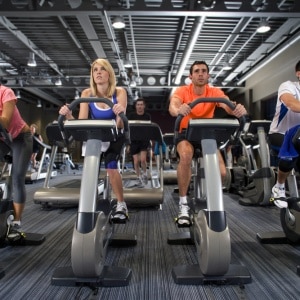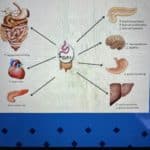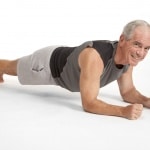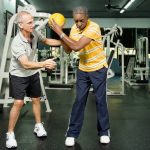 June 2023
June 2023
How Exercise Might Delay or Prevent Cognitive Decline
Raise your hand if the thought of Alzheimer’s disease (AD) scares you as much as it does me. A Journal of Physiology (Jan. 2023) article reports that short bouts of intense exercise – what is popularly known as interval training (high energy outputs followed by low energy recovery phases) – “may help protect the brain from age-related cognitive decline by increasing production of a key protein involved in neuroplasticity, learning, and memory.”
We have addressed this issue here, here, and here if you wish to deep-dive into the aging/cognition matter even more.
Most studies of this nature tend to be small, with only 6 healthy males and 6 healthy females, ages 20-40. They each were put through a 20-hour fast, a 90-minute light cycling session, a high-intensity, 6-minute cycling test, and a combined fasting and exercise session. The researchers were looking for brain-derived neurotrophic factor (BDNF) which is strongly associated with healthy brain tissue.
The 6-minute high-intensity session elevated BDNF more than light cycling or fasting. This does not mean that 6-minute sprints WILL prevent cognitive decline or AD. It merely suggests that one piece of the puzzle might be included in many others to delay its progression.
For example, a study reported in ESSR (Apr. 2022) proposed that exercise “counters multiple forms of age-related molecular damage that initiate the senescence [the gradual deterioration of functional characteristics] program.”
And a PLOS ONE study (Mar. 2023) proposed that telomere (specialized ends of chromosomes) length is “associated with better brain health and lower risk of dementia.” And telomere length is associated with higher levels of fitness. Get it?
Where Fat Comes In Handy
We’ve all heard of carb loading, right? That’s what distance athletes used to do to prepare for a race: eat low-carb diets for a few days prior to the race while depleting stored glycogen in the muscles, then slam the body with simple carbs so the muscles super-saturate with glycogen. This tactic presumably prevented them from ‘hitting the wall’, that point when the body is so low on carbs that running gets harder and it feels like you can’t put your foot forward again.
Now, a Japanese study tried to turn the tables on that method. They offered 10 male very fit recreational runners one of 2 meals prior to a 1-hr run at very high intensity – 95% of their lactate threshold. Each served as his own control by repeating the protocol a week later. One meal consisted of 80% carb, 13% fat and 7% protein (CARB); the other was 52% carb, 42% fat, and 7% protein (FAT); each meal was consumed 3.5 hours before the test run. Muscle and liver glycogen was assessed before the meal and pre- and post-exercise to determine which fuels were used during the run.
A little exercise science: RQ (respiratory quotient) is measured by a non-invasive air collection mode that determines the primary fuel. If mostly carbs, the RQ is close to or above 1.0. If mostly fats, it’s above 0.72 but well under 1.0.
As might be expected, the RQ was way lower during the FAT trial than during the CARB trial. And muscle and liver glycogen use was less during the FAT than CARB trial. They conclude that “one high-fat meal following carbohydrate loading reduced muscle and liver use” during the intense run. This might alter the pre-race strategies as it conserves stored glycogen quite well for later in the race.
JSCR Mar. 2023
Tid Bits
Prolonged sitting, as you are doing now, is unhealthy. Scientists have been exploring the ideal sit:move ratio to minimize the effects on blood sugar control, blood pressure, mood, and fatigue. A Columbia University study found that 5 minutes of walking every 30 minutes is better than 1 (or even 2 or 3, according to other studies) to reduce the negative effects of long-term sitting. MSSE Jan. 2023
Cardio training is essential for heart and brain health. But the push to make older adults push more metal keeps getting stronger. A recent study in the journal Antioxidants (Jan. 2023) tested UPR activation – a response of muscles under systemic stress, that diminishes with age, that protects them from oxidation – among a group of active, older adults in a resistance training program. They found that lifters’ inflammatory protein levels stayed unchanged. This suggested that UPR’s protective effects were maintained…one more reason to lift weights at least twice a week. IDEA Fitness Journal Spring 2023
With all the negative news about the modern diet’s overabundance of wasted calories in processed foods, a new theory out of Australia came to the fore: the protein leverage hypothesis (PLH). This proposed that humans always eat to the point where they consume enough protein to meet their needs…even if it’s poor-quality food. In other words, we will consume more/excessive amounts of calories until we meet our needs. A study found that “when people ate a fairly-low protein breakfast, they tended to consume larger amounts of food” and calories in the form of highly-processed foods than those who ate a higher-protein meal. The conclusion was that “protein deficits may play a central role in the obesity problem” of modern society. IDEA Fitness Journal Spring 2023

 June 2023
June 2023














